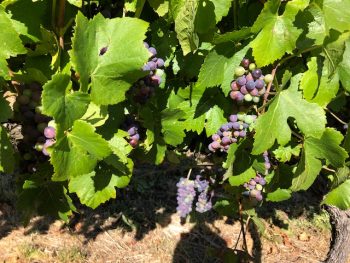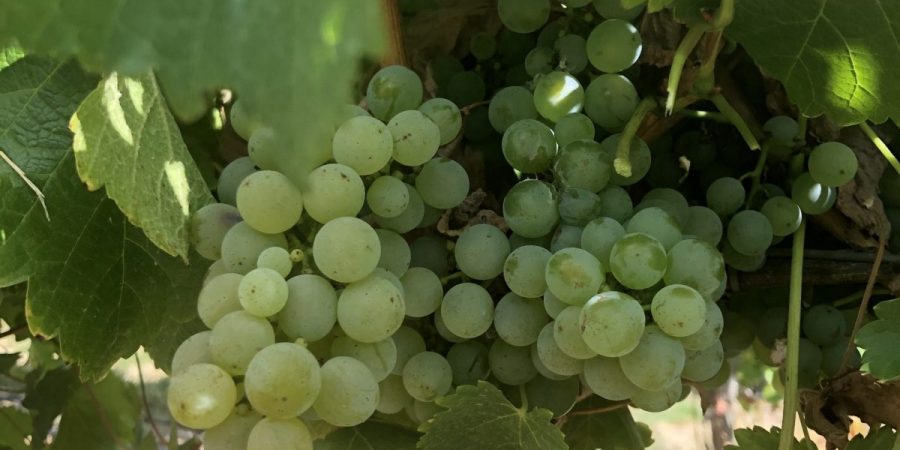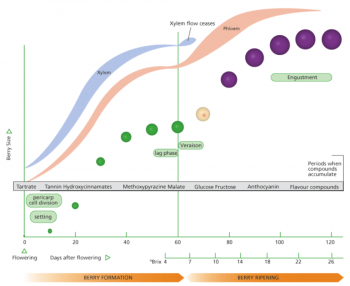Well, not actually.
Not quite yet anyway.
But how can you tell when grapes are ripe enough to pick and what happens in the lead up to that point?
We’ve talked a lot about veraison in the past posts (head on over to this post if you need a reminder), so I won’t go through that again. And while it is the most visually striking (and usually the first) indication that grapes are starting the ripening process, it’s not the only one.
Here is a somewhat complicated pretty picture you may wish to follow along with as I delve deeper into…
Berry development
First of all…
What is ripeness?
In viticulture, wine grapes are considered ripe at the completion of the ripening process (which I’ll explain in a bit) – it signals the beginning of harvest.
The thing is though, exactly what constitutes ripeness will vary depending on the style of wine. Each winemaker and viticulturist can have their own ideas about what constitutes ripeness.
Determining the optimal moment of ripeness for harvest is probably one of the most crucial decisions in winemaking.
Once the grapes are off the vine you can’t put them back on!
The ripening process
There are several factors that contribute to the ripeness of the grape.
We already know that as the grapes go through veraison, sugars in the grapes rise as acid levels fall. And it’s the balance between sugar and acid which is considered crucial to the winemaking process. Therefore winemakers keep a close eye on sugar levels and “total acidity” along with pH during the ripening process to determine the best time to harvest.
We have spoken about this in the past and I want to revisit it in the lead-up to harvest over the next couple of weeks.
What I’d like to concentrate on today though is the concept of physiological ripeness.
Physiological ripeness
 The idea of physiological ripeness (or physiological maturity) of grapes is a relatively new addition to the discussion of ripeness.
The idea of physiological ripeness (or physiological maturity) of grapes is a relatively new addition to the discussion of ripeness.
Physiological ripeness is a group of factors (beyond the standard measurements of sugars, acids, and pH) used to assess grape ripeness. These factors generally include evaluating the ripeness of tannins as well as the development of other compounds that contribute to the colour, flavour, and aroma of wine.
The concept of physiological ripeness is similar to the idea of engustment (a term coined by the French). It describes the stage of ripening when aroma and flavor become apparent. Research has shown that most aroma compounds develop in the berry as secondary metabolites. These occur late in the ripening process as the buildup of sugars level out. It is possible for a grape to be “ripe” in the context of sugar and acid levels but still be very immature when it comes to the development of tannins, aromas and flavour.
Most of these qualities are really tricky to measure. With experience winemakers and viticulturists learn to associate certain taste and characteristics with different stages of development. They evaluate the skin and pulp texture of the berry as well as the colour of skins and seeds. The lignification of stems (when they change from flexible and green to hard and woody) is also another sign of physiological ripeness.
Flavor precursors are flavorless compounds that occur naturally in grapes. When these components are “free” they are known as flavor compounds. When they combine with sugars in the grapes, they become glycosides or flavor precursors.
These compounds are found in tiny amounts, measured in parts per trillion! Through the action of acids and enzymes, glucosides derived from the sugar in the grapes go through hydrolysis, creating glycosides. These compounds are released during the late stages of winemaking and aging when they enhance flavor compounds. So, grapes with more flavour precursors have the potential to produce higher quality wine.
There are at least 200 of these compounds and scientists still have a lot to learn about them. We do know though that in red wine the intensity of colour is highly correlated with the concentration of flavour precursors.
Scientists have discovered it is possible to determine the presence of these compounds in the grape before harvest. It remains an area of continuing research and development.
Loving our blog? Sign up for weekly updates straight to your inbox…
So, how is ripeness progressing in the Hills?
I’m so glad you asked!
Vineyard update
According to last week’s CropWatch report, colour development in red varieties and softening in whites is progressing across the region. All varieties are currently between E-L 35 and 36.
As per previous reports, this vintage is currently likely to be late by 1-2 weeks. There is also the possibility that it will be compressed as later varieties have had the advantage of warmer conditions during the last stages of berry development and in the early stages of ripening.
Smaller crops combined with good-sized canopies, which have finally developed, are likely to lead to early harvest. Large crops, particularly in late varieties, may be delayed in the final stages of their ripening as the current weather is more autumnal than late summer in its nature.
And what does this all mean for Somerled?
Rob still needs to take a proper look, but he’s quietly confident that the Pinot Noir at Paul Henscke’s vineyard in Summertown will be ready for picking towards the end of next week!
Next week?!
No doubt I’ll have more news for you then!

